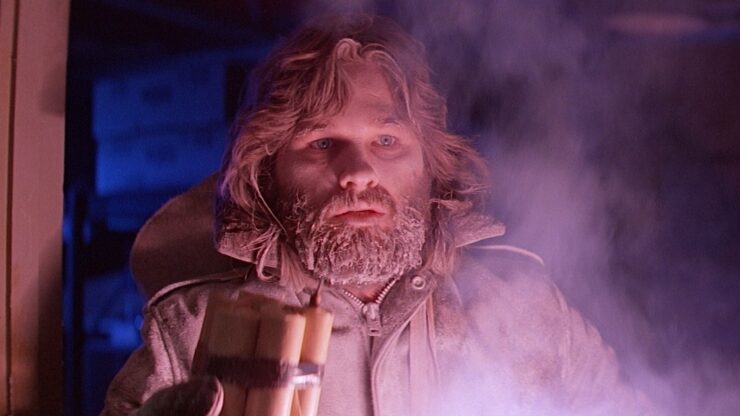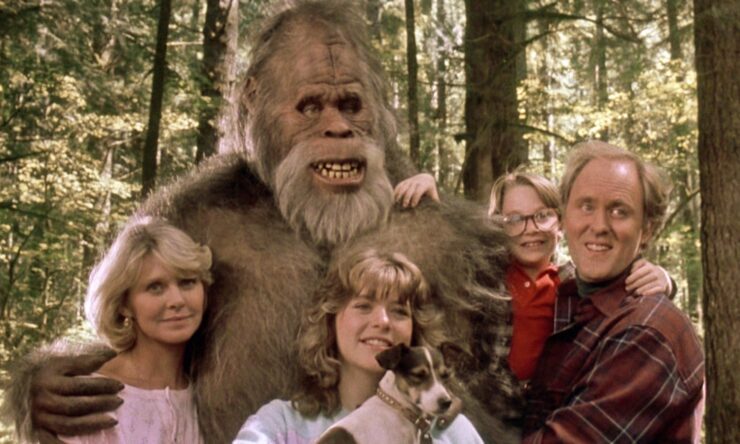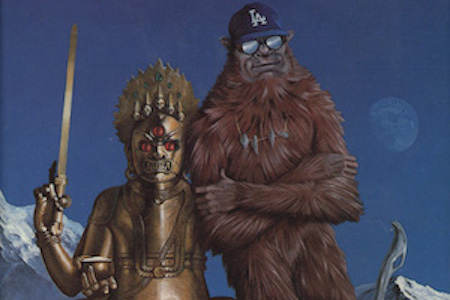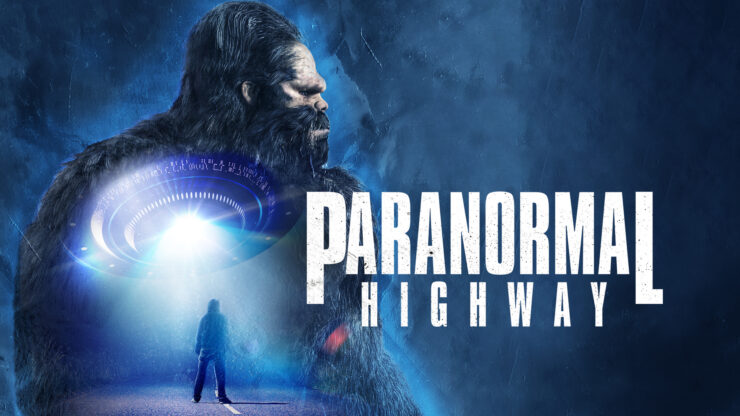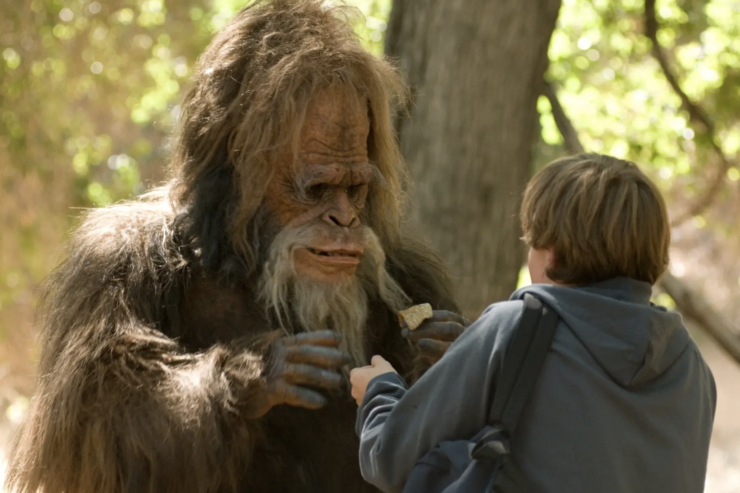It started as a novella, one of the classics of the genre: John W. Campbell, Jr. (writing as Don A. Stuart)’s “Who Goes There?” Howard Hawks made a movie loosely based on it in 1951, The Thing From Another World. Then in 1982, John Carpenter made The Thing, a closer retelling of the original. And finally, in 2011, Eric Heisserer wrote and Matthijs van Heijningen, Jr. directed a prequel to the Carpenter film, also called The Thing.
In Campbell’s story, an alien from outer space menaces a scientific station in Antarctica. The alien’s ship crashed in the far distant past, but a survivor emerged from it and sent out a distress signal which the station picked up. An expedition hunts down the signal and finds the ship, and the survivor frozen into the ice outside it. They bring the alien’s body back to the station, encased in ice.
The alien revives in the heat of the station, and begins stalking both the men and their sled dogs. The alien is a shapeshifter, and terribly dangerous. If it gets out of the frozen waste of Antarctica, it will consume every living thing on earth.
Howard Hawks moved the setting to the North Pole with an introductory section in Anchorage, Alaska, had the ship crash immediately before its discovery, and made the alien a plain old garden-variety predator. He added some interest by turning the mimic into a plant-based life form that feeds on blood and reproduces by means of seeds. The monster roars and snarls and gets electrocuted by our plucky group of scientists, after they’ve discovered that they can’t just shoot it down.
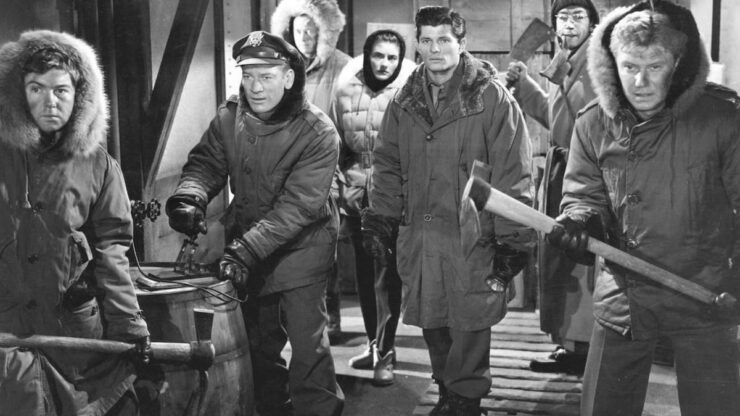
The film is distinctly low-budget. The Air Force plane is obviously a civilian craft with a “United States Air Force” banner taped onto the side. In at least one scene, somebody forgot to add the banner—the plane’s fuselage is blank. The alien is a big bald guy in a dark coverall, filmed from a blurry distance.
There’s a surprising amount of story in and around the Invader From Outer Space trope. Handsome Captain Hendry has a longtime thing going with gorgeous administrative assistant Nikki Nicholson. Dr. Carrington, Nobel laureate, loves to lecture, and often does; he insists on trying to communicate with the alien, and wants it kept alive and studied because science.
There’s a team of sled dogs that rides along in the plane and helps haul the ice-encased alien back to base. The base is fully staffed, and there are a number of characters back in Anchorage as well. Everybody has at least something to say at some point along the way, from the hitchhiking journalist to the general in Anchorage who sends a constant stream of irrelevant orders by radio as the people on the base fight to stay alive and kill the monster.
John Carpenter’s film, thirty years later, takes the story back to Antarctica, restores the alien ship to its ancient provenance, and has the special-effects budget to give us the mimic in full and gory glory. There are no women in this world. It’s all hairy, scruffy, grumpy men. The pilot in this version is RJ MacReady, who spends his free time deep in a magnum of J&B Scotch (nice product placement there) and playing computer chess—until the computer beats him and he fries it with Scotch on the rocks. The station crew is fairly numerous but fairly undefined: aside from a couple of medical doctors and a radio guy, it’s hard to tell what they’re doing in the wilds of Antarctica.

We don’t see the downed ship at the start of this one, or the alien in ice. That’s happened elsewhere. The film opens with a helicopter speeding over the frozen waste, pursuing a fleeing sled dog. There’s a guy with a rifle, shooting and missing.
The dog runs past the sign for United States National Science Institute Station 4, with the helicopter in hot pursuit. It drops a grenade and shoots at the dog, but wings George instead. One of the other crew members shoots down the helicopter before it can do any more damage.
The dog, by this time, has disappeared into the station. The crew are baffled. The Norwegians have only been in their own station for eight weeks—not nearly long enough to have gone crazy with the long Antarctic winter.
MacReady and the station’s doctor fly over to the Norwegian station and find it a smoking ruin. There’s an empty ice sarcophagus, and nearby, a terribly distorted, burned and twisted body. They bring a stack of documents in Norwegian, a video, and the body back for study.
Doc Copper and assistant Blair begin an autopsy of the recovered body and the dead pilot. Meanwhile, the dog is banished to the kennel with the station’s dogs, where it proceeds to turn into a weird gruesome flayed-looking tentacled spidery thing that wreaks havoc among the dogs.
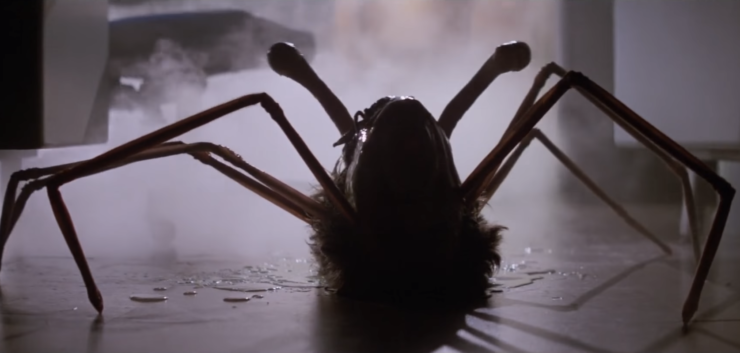
Doc figures out that the creature is an alien and it’s a mimic, able to transform itself into any living creature it meets. Mac follows a map recovered from the ruins, to an ice cave with an ancient spaceship and an empty rectangle in the ice.
Meanwhile, back at the station, the alien has started taking over members of the crew. Tension ramps up. Nobody trusts anybody else. The grue-and-gore factor is off the charts. We know nobody’s getting out of this, though some of them will try their damnedest. If even one of them succeeds, it’s game over for planet earth.
I am not a fan of gross-out horror. Carpenter loves it. The grosser, the gorier, the better. There must have been a buy more/get more sale on werewolf special effects in the early Eighties: that flayed dog head thrusting out of gruesome goo showed up all over the place.
This is a lot better film than I remembered. It rips through its story with dark glee. Kurt Russell plays a slightly softer version of his previous year’s Carpenter protagonist, the great Snake Plissken in Escape From New York. Ennio Morricone’s throbbing, dissonant theme music gets the blood pumping and the nerves jumping. And then there’s the dog, whom the X-ray app lists as “Jed: Dog.” Jed makes it all worthwhile.
The 2011 film, which really could have given itself a different title, isn’t as bad I thought it would be, either. It’s a direct prequel, following the story of the Norwegian station, the discovery of the crashed spaceship, the alien frozen in the ice. We see how the alien emerged from the ice and took over one after another of the crew, how it absorbed the dog, and what the crew had to do in order to destroy the alien—or try to. At the end, intercut with sections of final credits, we see the burning station, the helicopter, the rifleman—whose name and history we now know—and the fleeing dog.
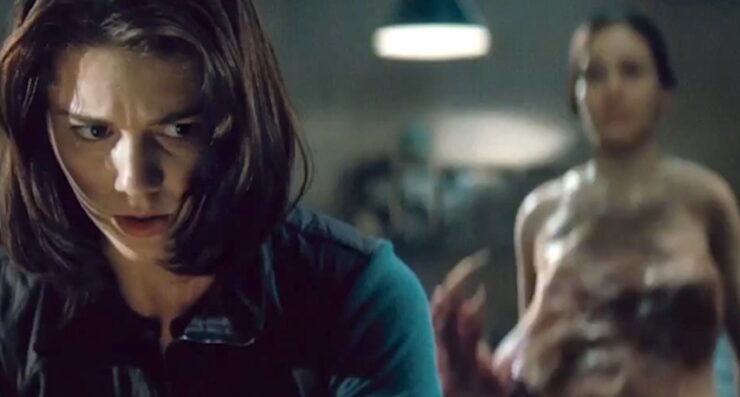
The prequel’s twist on the source material is the introduction of a young woman scientist, a paleontologist recruited to analyze the alien in the ice. There’s one other woman on the station, as there is in the Hawks film; she’s a much more minor character, who exists to be absorbed by the alien, but at least she’s there. Kate, the protagonist, rather resembles Nikki from the Hawks film, and shares some of her outlook on the world. Kate however, being a character of the new millennium, ends up taking charge, though it’s not clear at the end whether she actually survives.
The special effects in the prequel do their best to out-Carpenter Carpenter. More spidery limbs. More tentacles. Bigger monsters. Nastier monsters. Echoes of The Human Centipede. The uncanny valley gapes into a Grand Canyon of horrifically distorted human and canine anatomy.
It’s all about the gross-out and the galloping horror. The alien is pure predator. Nobody tries to communicate with it—there’s no Carrington to imagine it’s possible. It just wants to swallow up humans and animals and turn them into grotesque monsters. We know it can mimic a living thing perfectly, we watch Kate and company turn themselves (sometimes literally) inside out trying to spot the alien, but the film spends more time making monsters than tracking down perfect imitations of humans and animals.
The point is to horrify, and that’s what the film does. It gives us a dose of Strong Female Character, an echo of the Hawks film and the Campbell story. It segues directly into the Carpenter film.
I like my shapeshifters to have other dimensions than Big Monster Eat Dog Eat Human. But for what they are, these three films are rather fun. They’re just the thing to be watching this week, as Iditarod dog teams finish their thousand-mile race from Anchorage to Nome. I’ll raise a glass to Jed the dog, and hope he had a good life, whatever became of him after his star turn in John Carpenter’s creepy corner of Antarctica.
Judith Tarr is a lifelong horse person. She supports her habit by writing works of fantasy and science fiction as well as historical novels, many of which have been published as ebooks. She’s written a primer for writers who want to write about horses: Writing Horses: The Fine Art of Getting It Right. She lives near Tucson, Arizona with a herd of Lipizzans, a clowder of cats, and a blue-eyed dog.










